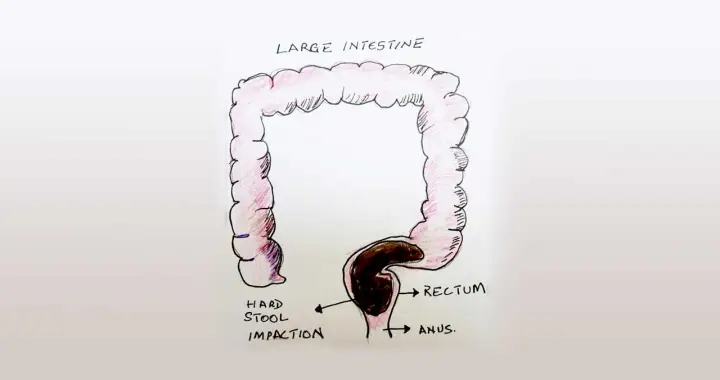Fecal impaction is when a large amount of poop is stuck inside the rectum. The poop can be soft or hard. Chronic constipation is the most common cause of impaction. Constipation is due to 1) the inability to push stool out 2) the persistent habit of holding bowel movement inside or 3) small stools that pile up. Impaction is often, but not always, uncomfortable. Frail seniors are at higher risk. Sometimes caregivers are surprised to hear that a patient has an impaction.
What are signs of impaction?
Impaction is likely when a patient feels full or uncomfortable but cannot push poop out. Sometimes, only a small amount comes out. Later, more bowel movement comes out after a person is “finished”. The stool can also squeeze out as liquid. When a finger is put in the rectum, stool can be felt. Occasionally, an impaction is higher up in the colon and visible only by x-ray.
Management: important but not easy
Let’s face it. Cleaning out an impaction is no fun. It is too late to add fiber or use a mild laxative. Poop must be unplugged and removed. It is an important but messy job. As impaction worsens, the task becomes more difficult.
1. Suppositories:
The easiest way to start is with a rectal suppository. Make sure the suppository is inserted completely. The suppository won’t work if it slips out right away. It should be placed against the inside wall of the rectum.
Glycerin suppositories are gentle and work by lubrication. The most common complaint is discomfort when it is put in. If it is effective, poop will be produced within one hour. If the impaction is mild but there is no result, try another glycerin suppository the next day.
Bisacodyl (Dulcolax) suppositories are more powerful and act by stimulating contraction of muscles. My experience with frail patients is that the result can be too strong and uncomfortable. For that reason, I start with a child’s dose, ½ of a suppository. The result is within 30 minutes. If there is no result, I try a ½ suppository an hour later.

2. Enemas should be used only when other efforts fail.
Use a standard pre-packaged enema from the drugstore. The enema bottle holds a safe amount of fluid for frail elderly patients. I prefer mineral oil enemas. They lubricate and expand the rectum to help poop slide out. Make sure the oil is not cold
Patients should lay comfortably on their left side. The right leg should be bent and flexed upward. Pillows under the head and right leg are helpful. Two caregivers can work together. One caregiver gives the enema. The other caregiver keeps eye contact with the patient and keeps the body steady. Converse with and comfort the patient. Hold the patient’s hand and make sure the patient’s hand stays away from the rectum. Sheets and towels should be in place because it can be messy..

Apply some lubricant or antibiotic gel at the rectal opening. This makes insertion more comfortable. Before inserting the nozzle, squeeze a little oil out to determine how much pressure to use. Insert the nozzle slowly without using force. It can be an uncomfortable sensation. The patient must be relaxed. Have the patient take slow, deep, breaths.
After the nozzle is all the way in, squeeze the bottle gradually until it is empty. Then remove the bottle. Sometimes there is a tendency for the oil to come out as soon as the nozzle is removed. The patient should try to keep the oil inside for at least several minutes. Staying on the left side helps.
Results are sometimes immediate but can take up to an hour. Gentle massage on the lower left side of the abdomen can help. The patient can remain laying down. However, it’s even better if a patient can sit on the toilet. A caregiver should always stay close to a frail patient to assure safety.
Use enemas with care in frail patients. They should be used sparingly. Some patients have used enemas frequently for years. It’s unfortunate but these patients can become completely dependent on enemas.
3. Healthcare providers:
A visit with a healthcare provider is needed when impaction cannot be managed by a caregiver. Gastroenterologists are the most expert at managing this problem.
Successful disimpaction, what’s next:
Patients are usually tired after disimpaction. Make sure the patient gets good rest over the next several days. When the patient is stronger, give some polyethylene glycol laxative (Miralax) in follow-up. With the blockage improved, the laxative can help remove remaining stool.
Impaction also tends to be recurrent in frail seniors. Do your best to avoid that. The best treatment for impaction is to avoid it in the first place. Please refer to the previous post: Constipation Relief … What’s the Scoop?
Here is a link to instructions about how to use an enema: www.fleetlabs.com/how-to-use-fleet
Constipation, a novel approach

There’s a new treatment for constipation. It’s a capsule that vibrates!! Activate the capsule and then swallow it. Once it’s swallowed the capsule periodically vibrates as it makes its way down to the intestines. The vibration stimulates muscles in the intestines and improves constipation.
The capsule is FDA approved. The company is pursuing coverage by medical insurance. Here is the link to the company: www.vibrantgastro.com
Warmest Aloha,
PS: I say it over and over again: There’s no one more important than the caregiver in the daily life of a frail person.


Leave a Reply